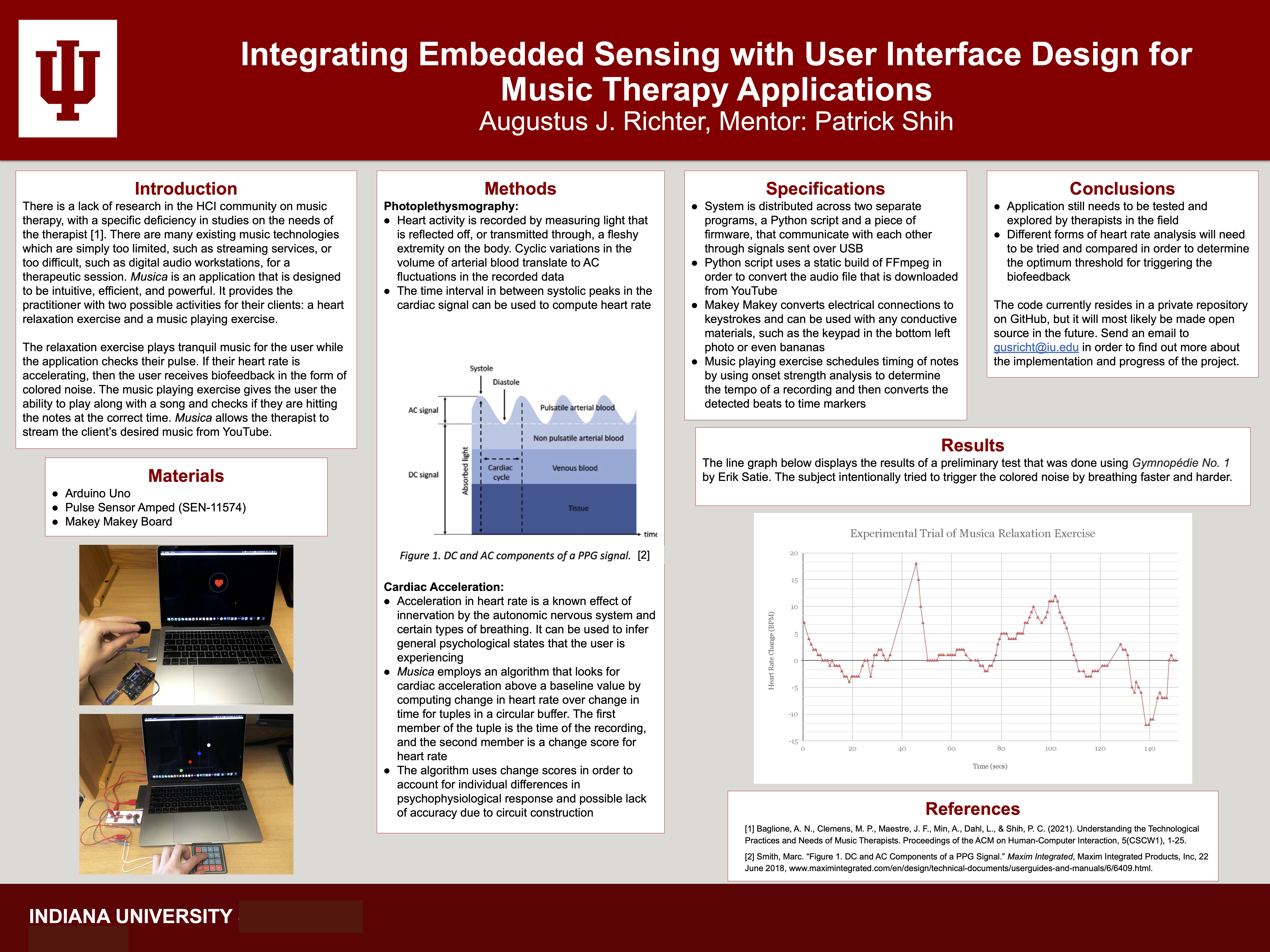HCI Research Into Auditory Feedback for Relaxation
During the summer of 2021, I participated in the STEM Summer Research program hosted by the Undergraduate Research office at IU. The program was eight weeks long and consisted of multiple student research groups that were each led by a faculty researcher. My group was composed of one other student and I; we conducted informatics research into human-computer interaction. We were interested in analyzing how digital interfaces for audio creation and manipulation could be used in music therapy contexts. By the end of the program, I had designed and built an application that provided a heart relaxation exercise and music play-along exercise.
Research Background
Interfaces that support creation and manipulation of audio have been used in music therapy contexts for many years now. Examples include incorporating digital audio workstations and MIDI instruments into therapy sessions. Previous research has demonstrated cases where an audio feedback system can be used to help induce relaxation in the user of the system. Our group decided to design an interface that played music for the user and added colored noise sources to the music in response to the onset of cardiac acceleration.
Oftentimes, self-report surveys are collected to analyze the effect of music therapy practices. However, self-report data is susceptible to a myriad of issues such as cognitive bias. Psychophysiological measurements can cut through these issues though the techniques are usually invasive. While the invasiveness may not be an issue for research, it is an issue if we want to make the interface biologically data-driven. PPG sensors provide a good balance between user comfort and analytic power. Techniques such as electroencephalography and facial electromyography provide deep insight into information such as emotional valence, relaxation, and attention. However, the electrodes and skin/scalp preparation process are too invasive for regular therapeutic use. Photoplethysmography provides enough insight into information such as attention and relaxation while remaining relatively uninvasive.
The interface that I made was called Musica. It allowed the user to upload an audio recording or select a song on YouTube to stream using the youtube-dl and FFmpeg command-line tool. The user also picked a specific color noise source. Then, the application enters an initial data collection phase. The user straps a PPG sensor onto their finger; the sensor is attached to an Arduino microcontroller which is connected to the PC over USB. The application collects five minutes of cardiac data from the user to get a baseline value for their heart rate. The PPG signal is converted to heart rate by differentiating the signal to find the systolic peaks and then dividing the time distance between two adjacent peaks by 60,000. The application then moves into the final relaxation phase. The song the user selected plays while the application continuously collects heart rate data and computes a change scores heart rate value. Change scores are used to account for individual differences in psychophysiological response and for possible inaccuracy due to the sensor's design and construction. The application differentiates the change scores computations and introduces noise to the song if repeated acceleration above the baseline is detected.
The second exercise the user can pick to participate in is a music play-along activity. The user selects or uploads a song, and the application extracts the rhythmic structure and tempo from the song using the Librosa package. Then, the interface constructs a graphical interface that mimics the Guitar Hero game. Notes/circles fall down the screen that correspond to beats in the song, and the user has to play the notes when they reach the bottom of the screen. The user plays the notes using a Makey Makey board which can serve as alternate keyboard input for the computer.
The research poster below was made at the end of the program and presented at a poster session. It contains more information on the sensor processing and music therapy research.
Image Gallery
 Final Summer Research Poster
Final Summer Research Poster
 Heart Relaxation Exercise with PPG Sensor and MCU
Heart Relaxation Exercise with PPG Sensor and MCU
 Music Playback Exercise with Makey Makey
Music Playback Exercise with Makey Makey
 Musica Settings Page for Selecting Song
Musica Settings Page for Selecting Song